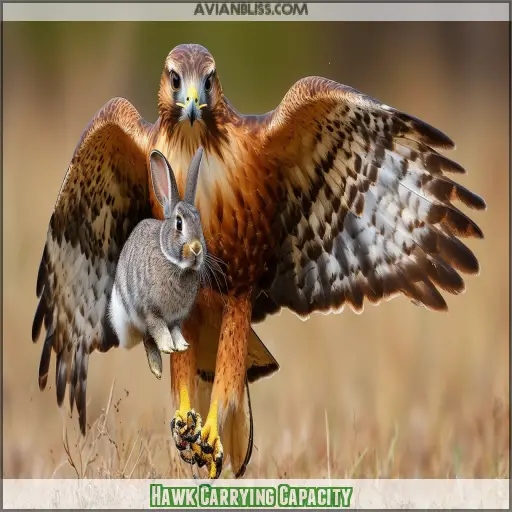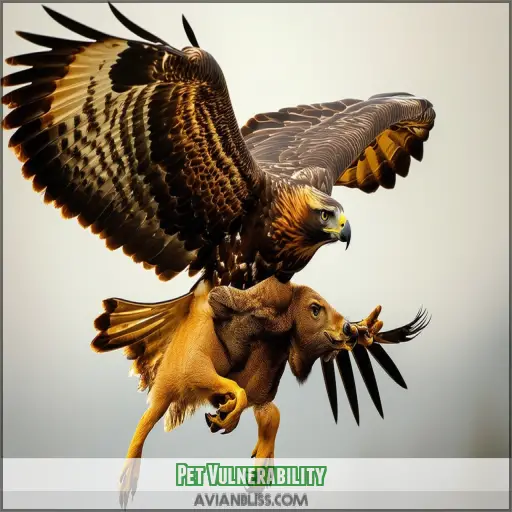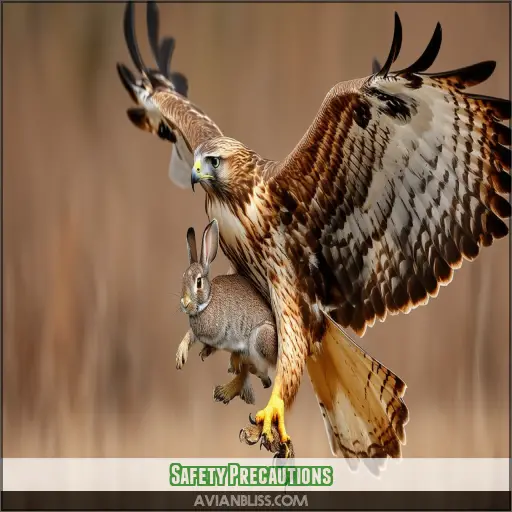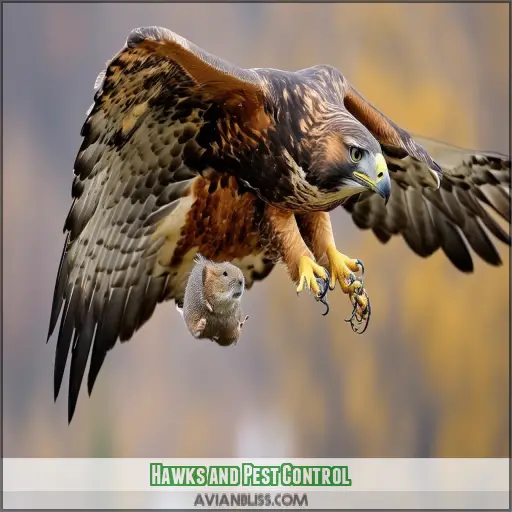This site is supported by our readers. We may earn a commission, at no cost to you, if you purchase through links.

The red-tailed hawk, weighing around 2 pounds, can carry prey double its weight – up to 5 pounds!
The great horned owl, with its 3-pound frame, can subdue even larger prey.
Keep in mind, though, that the weight limit varies based on the prey’s type and density.
While small pets like birds, snakes, and mammals under 5 pounds are vulnerable outdoors, you’ll discover effective safety measures to protect your furry friends as we explore further.
Table Of Contents
Key Takeaways
- Whoa, these raptors aren’t messing around! A red-tailed hawk, despite weighing a mere 2 pounds, can haul prey twice its size. Now that’s some serious heavy lifting for such a lean, mean, flying machine!
- While your average tabby or Chihuahua might not be on the menu, it’s best to keep a watchful eye on smaller furry friends under 15 pounds when these winged hunters are prowling about. Better safe than sorry, as they say!
- Hey, who needs a fancy alarm system when you’ve got reflective tape and decoy owls on guard duty? These visual tricksters give hawks the heebie-jeebies and shoo them away from your backyard buffet.
- Don’t forget, behind those piercing raptor eyes lies a brilliant mind for pest control. These feathered warriors are nature’s own rat patrol, keeping those pesky rodents from running rampant and ruining your crops or spreading unwanted diseases. Three cheers for our winged warriors!
How Much Weight Can a Hawk Carry?
How much weight can a hawk carry? Hawks can lift prey up to their own body weight, usually around 1-3 pounds for most hawk species. Very large hawks like ferruginous hawks may be able to carry up to 5 pounds.
Hawk Carrying Capacity
You’re fascinated by the hunting prowess of raptors, right? As apex predators, hawks’ carrying capacity demonstrates their power and mastery over the food chain. While these birds can’t defy physics, some species pack a serious punch.
Red-tailed hawks, for instance, weigh around 2 pounds but the strongest can haul prey double their weight! This predatory dominance extends to great horned owls too, with a 3-pound frame capable of subduing larger quarry.
Understanding these weight limits offers insights into the hawks’ natural behavior and the vulnerability of potential prey species. Just don’t lose sight of reality – raptors very rarely pose threats to humans.
Weight Limits for Prey
When it pertains to weight limits for prey, hawks are governed by their own size.
A red-tailed hawk, weighing around 2 pounds on average, can carry prey up to 5 pounds. However, that’s an outlier; most won’t attempt to take down prey heavier than themselves.
For a great-horned owl averaging 3 pounds, that limit is likely lower. Knowing the prey type is important too – a hawk may struggle with a dense chicken compared to a hollow-boned songbird of the same weight.
Safety concerns arise with larger raptors and smaller pets or rodents, making raptor deterrents like owl decoys wise investments.
With some sensible precautions, you can appreciate these amazing hunters while mitigating risks.
Pet Vulnerability
As a responsible pet owner, it’s critical to take into account the potential vulnerability of your furry companions when it pertains to hawks. While small mammals, birds, and snakes may be the typical prey, some larger red-tailed hawks possess the capacity to carry pets weighing up to 5 pounds, making even small dog and cat breeds susceptible to such threats.
Small Mammals
Small mammals like rabbits, squirrels, and chipmunks are prime targets for hawk hunting. Their diet analysis reveals a preference for these agile prey, selecting habitats rich in these food supplies. As a pet owner, be vigilant when allowing smaller mammals outdoors, as they’re vulnerable to aerial predators seeking an easy meal.
Birds
You might be surprised to learn that hawks also prey on birds, thanks to their keen eyesight and swift hunting skills. These raptors have evolved to spot and swoop down on smaller avian species, from backyard songbirds to poultry like chickens. Their hooked beaks and sharp talons make them formidable predators in both urban and rural habitats.
Snakes
You should also watch out for snakes if you have a hawk nesting nearby. These raptors often hunt:
- Garter snakes
- Rat snakes
- Other small, non-venomous species
Snakes make up a significant part of the diet for many hawks, so make sure to provide proper habitat protection for these important prey animals.
Dogs and Cats
While hawks generally hunt small mammals, birds, and snakes, you needn’t worry about larger pets like dogs and cats. Larger red-tailed hawks could potentially prey on small dog or cat breeds under 5 pounds. However, these raptors typically avoid confrontations with bigger animals. For pets under 15 pounds, Hawks Aloft recommends supervision during outdoor activities.
Safety Precautions
To safeguard your pets, it’s paramount to exercise constant oversight when they’re outdoors, particularly for those weighing under 15 pounds. Furthermore, affixing reflective tape or employing decoys can dissuade hawks from approaching, but human supervision remains the most effective preventive measure against potential hawk encounters.
Supervision for Pets
You must be vigilant to protect your pets from hawks. Never leave small pets unsupervised outdoors, especially those under 15 pounds. Cats should remain indoors, and dogs should be on a leash during outdoor activities. Human attentiveness is paramount for predator avoidance and ensuring your furry friends’ safety. With diligence, you can deter these winged hunters from threatening your beloved companions.
Reflective Tape and Decoys
Using visual deterrents like reflective tape or owl decoys can effectively scare hawks away from your property. In unnatural settings, these deterrents exploit hawks’ natural caution and human fear of potential attacks. Placement around bird feeders is critical to prevent captive behavior by hawks, which may target these areas for easy prey.
Human Supervision
While tape, decoys, and deterrents help, vigilant human supervision remains your best defense against hawks snatching small pets. Monitor outdoor playtime closely, especially for animals under 15 lbs. This hands-on approach minimizes risks while respecting the hawks’ role in local ecosystems and avoiding unnecessary conflict or disruption.
Hawks and Pest Control
Hawks prey on small mammals and birds. They also help control rodent populations that can harm crops and spread disease.
You’ve likely seen these majestic hunters soaring overhead, their keen eyesight scanning for pesky rodents scurrying below.
By allowing hawks to thrive in your area, you’re enlisting nature’s pest control experts to keep rat and mouse numbers in check.
So, the next time a hawk snatches up a field mouse, consider it a free pest removal service, courtesy of these winged warriors.
Their role in the ecosystem is invaluable – just another reason to admire these impressive birds of prey.
Frequently Asked Questions (FAQs)
Do hawks ever attack and carry humans?
With fierce talons like scimitars, hawks seldom harm humans – their reptilian gazes focus on rodents and birds. While the improbable exists, unnatural settings pose the only true danger of attack. Breathe easy: these winged wonders soar far from our sphere.
Can hawks lift small children off the ground?
While extremely rare, it’s theoretically possible for a large hawk or eagle to temporarily lift a small child. However, birds of prey can’t sustain flight while carrying massive weight. Supervision is imperative for kids outdoors near raptors.
What birds pose a threat to humans?
While raptors like eagles can injure, credible evidence of them carrying children is scant. For humans, hawks like the red-tailed pose minimal threat – focus on safeguarding small pets under 15 pounds through supervision.
How high can hawks fly with prey?
Hawks can soar up to dizzying heights with their prey. While carrying heavier loads, they typically fly lower to conserve energy. Their aerial prowess allows them to effortlessly transport meals back to their nests or perches for dining.
Can hawks differentiate between pets and prey?
While hawks primarily hunt small prey like rodents, they can differentiate between pets and natural prey. However, for safety, it’s best to supervise pets under 15 pounds when outdoors due to the slight risk of a predatory hawk mistaking them for legitimate prey.
Conclusion
In the wild, hawks can lift prey up to three times their body weight. Recognizing a hawk’s carrying capacity and taking appropriate safety precautions are essential to protect small pets from these apex predators.
Vigilant supervision, deterrents like reflective tape, and swift intervention if a hawk is nearby can safeguard your furry friends.
Understanding how much weight a hawk can carry equips you to mitigate risks and coexist responsibly with these remarkable birds of prey.








